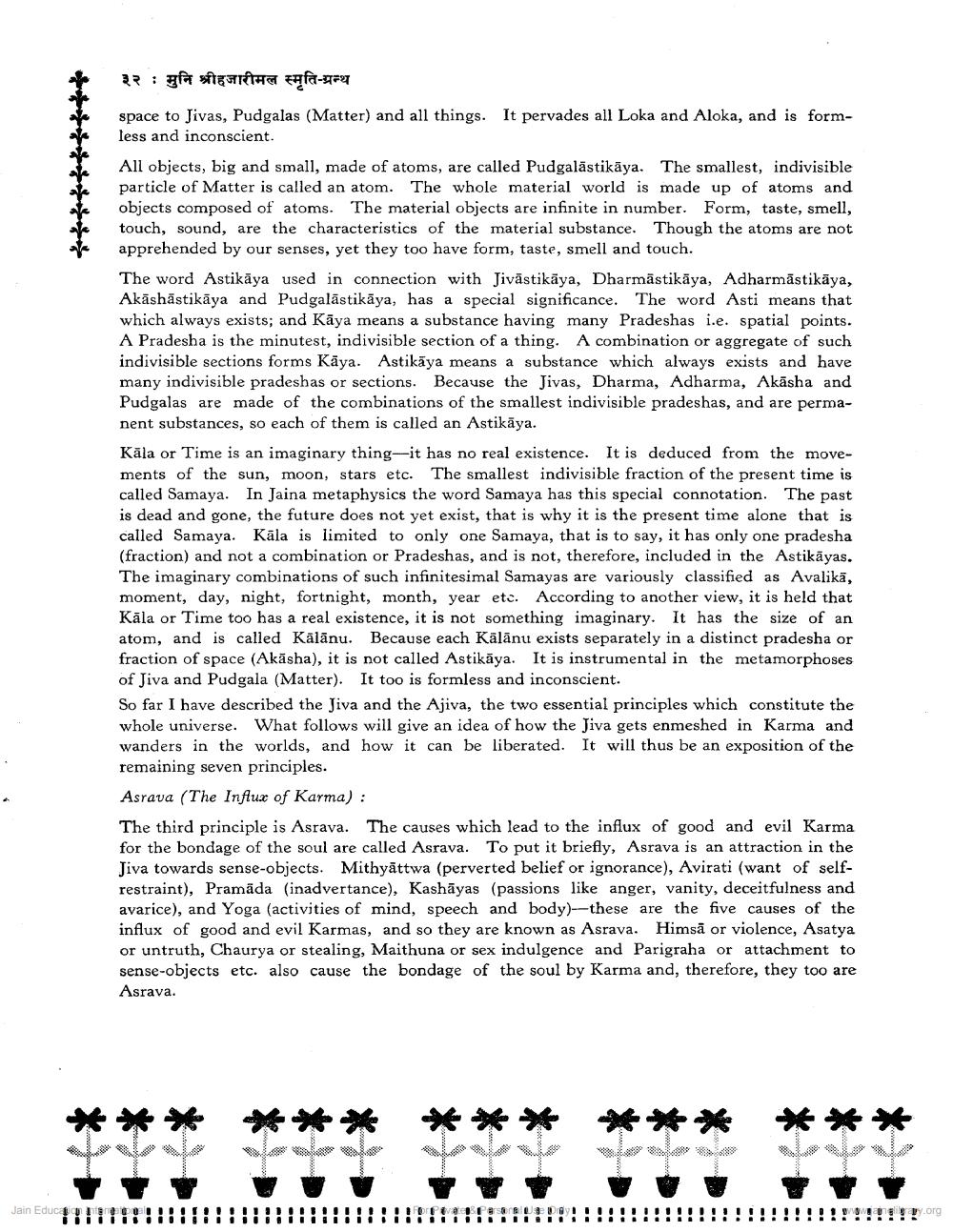Book Title: Doctrines of Jainism Author(s): K B Jindal Publisher: Z_Hajarimalmuni_Smruti_Granth_012040.pdf View full book textPage 3
________________ २२ मुनि श्रीहजारीमल स्मृति ग्रन्थ space to Jivas, Pudgalas (Matter) and all things. It pervades all Loka and Aloka, and is formless and inconscient. All objects, big and small, made of atoms, are called Pudgalāstikāya. The smallest, indivisible particle of Matter is called an atom. The whole material world is made up of atoms and objects composed of atoms. The material objects are infinite in number. Form, taste, smell, touch, sound, are the characteristics of the material substance. Though the atoms are not apprehended by our senses, yet they too have form, taste, smell and touch. The word Astikaya used in connection with Jivastikāya, Dharmastikāya, Adharmastikāya, Akashāstikaya and Pudgalāstikāya, has a special significance. The word Asti means that which always exists; and Kāya means a substance having many Pradeshas i.e. spatial points. A Pradesha is the minutest, indivisible section of a thing. A combination or aggregate of such indivisible sections forms Kāya. Astikaya means a substance which always exists and have many indivisible pradeshas or sections. Because the Jivas, Dharma, Adharma, Akasha and Pudgalas are made of the combinations of the smallest indivisible pradeshas, and are permanent substances, so each of them is called an Astikāya. Kāla or Time is an imaginary thing-it has no real existence. It is deduced from the movements of the sun, moon, stars etc. The smallest indivisible fraction of the present time is called Samaya. In Jaina metaphysics the word Samaya has this special connotation. The past is dead and gone, the future does not yet exist, that is why it is the present time alone that is called Samaya. Kāla is limited to only one Samaya, that is to say, it has only one pradesha (fraction) and not a combination or Pradeshas, and is not, therefore, included in the Astikāyas. The imaginary combinations of such infinitesimal Samayas are variously classified as Avalikā, moment, day, night, fortnight, month, year etc. According to another view, it is held that Kāla or Time too has a real existence, it is not something imaginary. It has the size of an atom, and is called Kālānu. Because each Kālānu exists separately in a distinct pradesha or fraction of space (Akasha), it is not called Astikaya. It is instrumental in the metamorphoses of Jiva and Pudgala (Matter). It too is formless and inconscient. So far I have described the Jiva and the Ajiva, the two essential principles which constitute the whole universe. What follows will give an idea of how the Jiva gets enmeshed in Karma and wanders in the worlds, and how it can be liberated. It will thus be an exposition of the remaining seven principles. Asrava (The Influx of Karma): The third principle is Asrava. The causes which lead to the influx of good and evil Karma for the bondage of the soul are called Asrava. To put it briefly, Asrava is an attraction in the Jiva towards sense-objects. Mithyattwa (perverted belief or ignorance), Avirati (want of selfrestraint), Pramada (inadvertance), Kashāyas (passions like anger, vanity, deceitfulness and avarice), and Yoga (activities of mind, speech and body)--these are the five causes of the influx of good and evil Karmas, and so they are known as Asrava. Himsā or violence, Asatya or untruth, Chaurya or stealing, Maithuna or sex indulgence and Parigraha or attachment to sense-objects etc. also cause the bondage of the soul by Karma and, therefore, they too are Asrava. *** Jain Education Interes *** *** *** gy.orgPage Navigation
1 2 3 4 5 6 7 8 9 10 11 12 13 14 15
